William Walmsley
Co-Founder of Swallow Sidecars
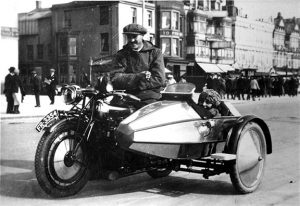
William & Emily Walmsley
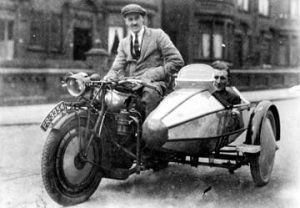
William Walmsley
& Williams Lyons (in sidecar)
William Walmsley is often forgotten for his contribution to the Jaguar story; he may, in fact, be called the ‘originator’, as it was Walmsley who designed and built the first Swallow sidecar on which the business was founded.
Walmsley, the son of a prosperous coal merchant, was born in Stockport in 1892. He was educated locally and on leaving school spent some time in the family business, where he learned about building coal waggons. Walmsley was due to follow his father into the coal transportation business, but he joined the Cheshire Yeomanry Regiment in 1911. During World War One he served in Egypt, Palestine and France, where he received a gun-shot wound to his right leg and by the end of the war he had worked his way up to sergeant. On the return of peace, Walmsley moved back to the family home – Fairhaven in Flowery Field, Stockport – and with a recently-acquired ex-War Department Triumph motorcycle. He spent his time rebuilding the Triumph which attracted the attention of some of his motorcycling friends who had him rebuild their bikes too. Walmsley wanted a sidecar to go with his Triumph but none of those on the market at the time found favour; they were too tall and cumbersome, so he set about designing one of his own.
Walmsley was good with his hands and applied his skills to make an ash frame and fabricate a sidecar body out of aluminium panels, which he cut and fitted himself to an existing Watsonian sidecar chassis. The stylish design, which had a bullet-shaped streamlined octagonal body, was quite unusual and different from the other sidecars then on offer.
Walmsley gave the design the name ‘Ot-as-Ell’. It was on the road by mid-1920 and he registered the design as a Swallow Sidecar on 7th April 1921. Friends of Walmsley admired the design and asked for examples to be built for them.
Building Sidecars
Whether Walmsley wanted to go into business building sidecars is not clear but he formed an informal partnership with his brother-in-law, Fred Gibson, and with the aid of a couple of local helpers, he set about the task of manufacturing replicas of his sidecar. Using the garage attached to his parents’ house, and also a nearby lock-up garage attached to the Bamford Arms Hotel, work commenced on fulfilling the orders; at this stage the sidecars were trimmed by his sister Winifred (Mrs Gibson). The chassis were (probably) supplied by Haden of Birmingham who also built sidecars. Walmsley rode his own sidecar combination, illegally, until 28 January 1921, when he registered it and made it road legal.
With so much interest in the sidecar, Walmsley realised that there was potential for further business and, to protect the design, he had it registered on 7 April 1921, through the patent agents F. Rosshardt of Corporation Street, Manchester. Walmsley also had some postcards printed with a photograph of the sidecar giving details of the product.
It was priced at 28 Guineas ( 1 Guinea = £1 1s or £1.05) in its basic form; for an additional 4 Gn the hood, screen, lamp and wheel discs could be added. The postcards were distributed in the Stockport area as a form of advertising, with the claim that this ‘chair’ was ‘made to sit in, not on.’ However, Walmsley only regarded the ‘chair’ as a hobby and was not really interested in making building sidecars a full-time business.
When his father, Thomas, retired in June 1921, the family moved to 23 King Edward Avenue in Blackpool; the house was called Swallowdene. Here, Walmsley continued to build the sidecar on an ad-hoc basis with a couple of helpers. He still fabricated the panels himself and advertised it locally for £28 adding the slogan ‘Ot-as-Ell’. A young enthusiastic motorcyclist neighbour in King Edward Avenue got into conversation with Walmsley and when he saw the sidecar he immediately ordered an example. This young man was William (then known as Billy) Lyons and he introduced Walmsley to the Blackpool and Fylde Motor Club, the members were impressed by the Swallow and several more were ordered.
The Walmsley house in Stockport was sold to a Mr. G W Swallow and Walmsley started to use the name ‘Swallow’ about this time. There may have been a link but no evidence has come to light to support this!
Swallow Sidecars Goes Professional
With no proper advertising the sidecar was being ordered by people who simply saw an example in the street and Walmsley seemed content to indulge in what he regarded as a hobby and do nothing further to promote the product. William Lyons was just twenty when he took delivery of his sidecar and was quick to see the potential of the product if it was marketed correctly. He suggested a business partnership with Walmsley, but the older man was reluctant to do so; he had no need to work and did not have the drive that Lyons possessed. Lyons did not give up and discussed the matter with Walmsley’s father, Thomas. He was more receptive and talked his son into the scheme, leaving Lyons to sort out the business plan.
In August 1922, William Lyons senior and Thomas Walmsley put up £500 each to fund the enterprise by guaranteeing a £1,000 loan (roughly £60,000 in 2021 terms) at Williams Deacon’s Bank in Blackpool. They found suitable premises at 5 Bloomfield Road and the partnership agreement was signed on 21 November though it was backdated to 11 September 1922. Interestingly, the name ‘Swallow’ is not mentioned on any of the surviving documents from this time, but from the very start they traded as the Swallow Sidecar Company. Lyons paid Walmsley £50 for a license to manufacture the Swallow sidecar and each of the business partners took a weekly salary of £10.
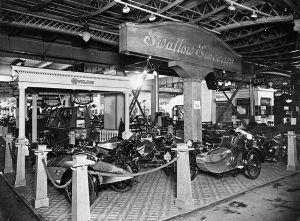
Swallow Sidecar Stand at the 1922 London Motor Show
William Walmsley and William Lyons began in a small way by initially producing just one motorcycle sidecar a week. Walmsley supervised the manufacturing aspect and the six employees, while Lyons looked after the advertising and administration. This worked well, and production increased to meet the orders placed for the Swallow. Lyons wanted to introduce the Swallow to a wider market and that meant London.
Unfortunately, the date for space at the Motor Cycle Show in London that November had to have been booked by April, and when Lyons approached the organisers he was told that the Show was fully-booked. Lyons was not to be deterred and pleaded with them to be allocated a stand. Even though the entry date had long passed, and the Hall fully booked, the organisers agreed to allow Swallow space if any became available. Fortunately, a last-minute cancellation gave them a small stand to display their products at the 1922 show. Lyons and Walmsley rode their newly-acquired Brough Superior V-twin SS80s and Swallow sidecars from Blackpool to London.
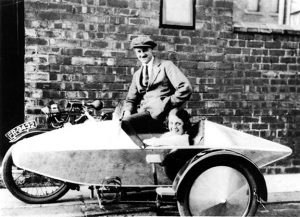
William & Emily Walmsley
in a Model 4 – five sided sidecar
The octagonal Model 1 sidecar was very popular and within two years it was joined by other models including a long-tailed five-sided Model 4 and a lozenge shaped Model 6 called the “Scrapper”. Walmsley and Lyons (probably) worked on the designs between them, there is no evidence to suggest who the prime mover was, but it would be safe to assume that the two men worked together.
There was also a problem with the Swift Company who complained that the Swallow depiction of a bird was too close to their own Swift motif and legal action was threatened. In the event, Swallow withdrew their 1922 catalogue, which had been badly printed anyway, and the bird redrawn so all was well. A few years later Swallow would manufacture a body for the Swift chassis.
Walmsley and the Swallow Cars
Interestingly, the first Swallow-bodied car was quite unofficial; from Stockport Fred Gibson sent Walmsley the burnt-out remains of an Austro-Daimler car which was delivered to Bloomfield Road. Here, Harry Gill, one of Swallow’s first employees, helped to make a new body while Arthur Whittaker rebuilt the engine and refurbished the chassis. Whittaker joined the business as a salesman and would rise through the ranks to become deputy-chairman of Jaguar. Those who worked on the car were paid additional funds by Walmsley as it was not part of their day-to-day tasks. Walmsley used the rebuilt car for some time as personal transport before he sold it locally. Sadly, no photographs of this vehicle have survived, though his first wife, Emily, recalled it as being ‘A very smart-looking car, even though it was not that reliable. I remember having to push it on more than one occasion.’
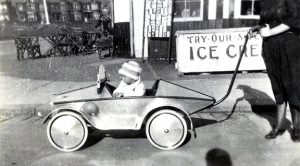
1922 Bobby Walmsley
in his Swallow Push Car
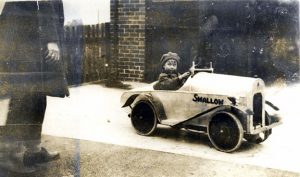
Bobby Walmsley
in his Swallow Pedal Car
A four-wheeler that was made by Walmsley was a sidecar-style push-car complete with wings, running boards, windscreen and leather seat. This was used to push Walmsley’s son Robert ‘Bobby’ along instead of the more usual perambulator.
Later, when Bobby grew out of the ‘pram his father made him a pedal-car; once again complete with wings, windscreen, leather seat and sidelamps atop the wings. Bobby would later attend Bloxham School in Oxfordshire and would sometimes be chauffeured to and from the school in his father’s SS I. On the outbreak of World War Two in 1939, Bobby joined the Royal Air Force and trained as a pilot; he was later posted to No. 3 Squadron flying Hawker Typhoon fighters. Bobby Walmsley was killed on 10 November 1943, when his Typhoon (JP426) was shot down during a raid on a V1 flying bomb launching site at Cap Gris Nez in Northern France.
Swallow Expands
When Lyons obtained an order for 500 Austin Swallow cars from Henlys, Walmsley was not impressed and thought Lyons was ‘mad’ to have agreed. He was concerned that the small factory would not be able to cope with an order of this magnitude. It may not have been easy but cope they did and Swallow were able to satisfy all their customers with sidecars and Austin-Swallows, as well as developing a four-seat Austin-Swallow saloon for Henlys. Walmsley also used a Clyno that had been given the Swallow body treatment and later an Alvis 12/50 chassis was re-bodied by Cyril Holland for use by William Walmsley.
William Lyons and William Walmsley were quite different in almost every way; the former was always looking to expand the business and finding new markets and products, while the latter was (generally) quite content to let the business look after itself. Walmsley was seen more often than Lyons on the factory floor talking to the workforce and he regarded himself as one of the boys, perhaps because he was a skilled wood and metal worker and understood much better than Lyons, who was not good with his hands, what was involved in manufacturing Swallow products. Walmsley was easy-going and treated life in a frivolous manner.
When Swallow had outgrown Blackpool it was Lyons who wanted to move to the Midlands, Walmsley was not too keen but, to his credit, he could see that a move was necessary and made several journeys to Coventry and nearby areas looking for suitable premises. At one stage he thought Wolverhampton would be suitable but when the possibility of buildings in the Foleshill area of Coventry came up he was in agreement with his business partner. Both men found suitable houses in the Earlsdon district of Coventry (Walmsley called his house Swallowdene) and in 1930 each of the partners bought a Vauxhall 20/60 Kingston Coupé. Walmsley’s car was painted brown and beige (a favourite Walmsley colour scheme) while Lyons’s was ivory with black fabric roof and trunk and black wings. For 1931 Swallow expanded into making a model to their own design. Lyons and Holland designed a long, low Coupé which was impractical to get into or out of, when Lyons was taken to hospital to have his appendix removed, Walmsley had the design of the car altered; the roof was raised several inches and made more practical. Lyons was horrified when he saw what had been done but there was no time to change the design before the car was due to be shown at the London Motor Show. The SS I was in production for a year before the design was changed totally for the 1933 season.
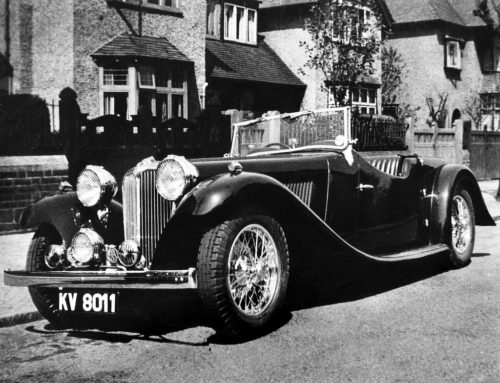
1934 SS1 ‘Walmsley Roadster’ KV 8011
Walmsley Bodied SS Cars
Walmsley liked the SS I and over the following years owned some six examples, as well as an SS II. He also designed and built two special cars for himself. These were both based on the SS 1 chassis which went into production in 1932 and powered by the 20 hp engine. These were not prototypes intended to go into production but cars for his personal use. He even had a firebell fitted to one of the cars – not something that would ever have been included on a production car.
Only one of these two survives, registered KV 8011 – built on a standard SS 1 chassis (Number 247564), utilising the Standard 2.5 litre, 6-cylinder, side-valve engine, a two-seater sports car with a disappearing convertible top and fold down windscreen. This currently resides in North America.
Walmsley Leaves The Company
William Walmsley spent little time in the day-to-day business at SS Cars and indulged in an all-consuming hobby of model railways; he had some of the staff paint backgrounds and the metal workers made various bits and pieces for the railway layouts. This was done in Company time and using Company materials, something that Lyons did not approve of and when he tackled Walmsley about it the latter shrugged it off. This sort of attitude helped to drive the two business partners further apart.
On 28 November 1934 the first Annual General Meeting of S.S. Cars Ltd was held and at the meeting William Walmsley gave notice of his resignation, as he did not want to see the Company go public on 11 January 1935. Lyons bought out Walmsley’s shares and assumed sole responsibility of S. S. Cars Ltd.
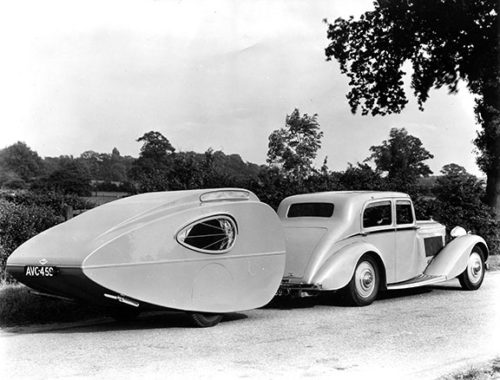
William Walmsley’s Airlite Caravan
Walmsley left after fifteen years with a handsome cheque; he used some of the money to buy shares in Clifford Dawtrey’s Airlite Trailers Company and also purchased a new Bentley. He wanted to tow one of the Airlite caravans and had a tow-hook attached, something that Rolls-Royce suggested was not advisable. Nevertheless, Walmsley had it fitted and later crashed the Bentley, it was not towing at the time, writing it off; he emerged unscathed. Walmsley replaced the Bentley with a Studebaker, a car that was more suitable for towing caravans.
Airlite failed after a few examples of their caravans had been sold and, in 1938, Dawtrey started another business, Coventry Steel Caravans, with some finance from Walmsley. When Coventry was bombed the caravan factory was destroyed but Dawtrey restarted it on another site in 1943. It was not a great success and was later sold off to Caravans International.
Dawtrey had worked for Swallow and started Airlite in his spare time, but he spent too much time on Airlite and not enough on Swallow, so Lyons dismissed him.
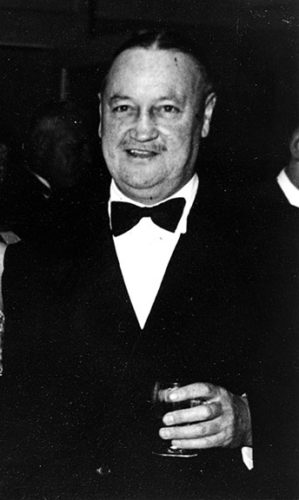
William Walmsley
William Walmsley enjoyed his post-SS Cars life, even though he was not as robust in health as he had once been. After World War Two he bought his first Jaguar and stayed faithful to the brand later owning examples of the Mark VII and Mark VIII. Both were used to tow caravans of some description.
In 1960 he left his home in Coventry for a new house at Poulton-le-Fylde near Blackpool. His health continued to deteriorate and on 4 June 1961 William Walmsley died just short of his sixty-ninth birthday. Edward Huckvale and Arthur Whittaker represented Jaguar Cars at the funeral. Lyons did not attend but a wreath was sent on behalf of the Company.
It was an interesting and fruitful business partnership without which Jaguar Cars may never have come about.
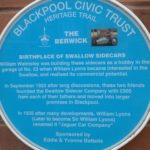
Blue Plaque at
The Berwick
Postscript
Walsmley’s house in King Edwards Avenue in Blackpool still exists but the rear garage from which the first Swallow sidecars emerged, is long gone.
The house is now run as a B&B, The Berwick, and Walmsley is commemorated by a blue plaque from Blackpool Civic Trust by the front door, and information on Walsmley and his role in Swallow and SS inside.
Authors: François Prins with additional information from Tony Merrygold
© Text and Images – Jaguar Daimler Heritage Trust
Sources and Further Reading:
-
Grimsdale, Peter, High Performance: When Britain Ruled the Roads (Simon & Schuster UK, 2020)
-
Lord Montagu of Beaulieu and foreword by HRH Prince Michael of Kent, Jaguar (Quiller Press, 1997)
-
Mennem, Patrick, Jaguar: An Illustrated History (The Crowood Press Ltd, 1991)
-
Whyte, Andrew, Jaguar: The Definitive History of a Great British Car (Patrick Stephens Limited, 1990)
-
Hull, Nick, Jaguar Design: A Story of Style (Porter Press International, 2015)
-
Porter, Philip, Jaguar: E-Type The Definitive History (Porter Press International, 2015)
-
Thorley, Nigel, Jaguar in Coventry: Building the Legend (Breedon Books Publishing Co Ltd, 2013)
-
Skilleter, Paul, Norman Dewis of Jaguar: Developing the Legend (PJ Publishing Ltd, 2017)
-
Porter, Philip and Skilleter, Paul, Sir William Lyons: The Official Biography (Haynes Publishing, 2001)
-
Porter, Philip, The Most Famous Car in the World: The Story of the First E-type Jaguar (Cassell, 2000)